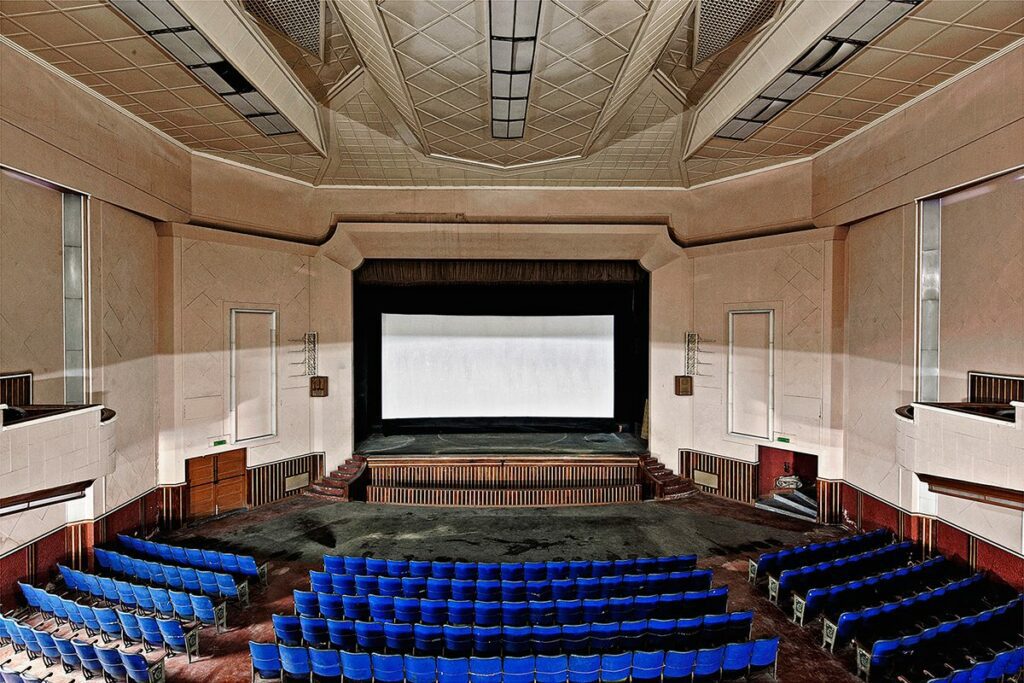Galeria Avenida da Índia, Lisboa, Portugal
29 Mar 2016 - 05 Jun 2016

Cine-teatro-Gil-Vicente,-Plateia-(Cine-theater-Gil-Vicente,-Audience),-2011
The exhibition Interior Landscapes is photographic project by Mozambican photographer Filipe Branquinho.
Originally produced in Maputo where it was shown in November 2015 until January 2016, a selection of photographs of the series “Interior Landscapes” was selected and shown at “Telling Time” – main exhibition of the 10th Biennale of Bamako (2015) the exhibition is now on view at Galeria Avenida da Índia, in Lisbon.
.
Narrating the city where he was born and where he now lives and works, learning the stories that crossed it over different times, of those who walk(ed) and inhabit(ed) it, of those who have and do built it, is the genesis of the photographic project entitled “Interior Landscapes”, developed over three years by the Mozambican photographer Filipe Branquinho.
Opening this series is an urban landscape, a polyptych revealing the current silhouette of Maputo’s historical centre as seen from Catembe. A perspective shared by many who enter the city in their daily commute by batelão, by tourists looking for a panoramic view, by travellers who, throughout times, unveiled different signs when reaching the city by sea. But also a challenge for its inhabitants, in the sense that they must drop routines, interrupt or suspend their daily routines daily voracity in order to start a (re)discovery of the city. In the cinema one would say the polyptych works as an establishing shot: showing the confluence of buildings from several different times and the greed of new construction in the centre of contemporary Maputo is, at the same time, an invitation to the city, to walk it, see it and feel it or, as defended by Júlio Carrilho, to get to know “Maputo, beyond the skin”.
“Architecture has taught me how to see, represent and perceive the way a building or city shape the life of its inhabitants, and how these transform them according to their ways and costumes”, Filipe Branquinho says in his interview to Sandra Vieira Jürgens. Distancing himself from a conventional documental record and from attempting to reveal iconic city buildings, in the series of thirty photographs “Interior Landscapes” Branquinho starts a journey through the public and semi-public spaces of the city, generally the inside of buildings saturated of traces and arcades, with history and clues, a permanent oscillation between present and past that catches the eye. Cinemas, radio stations, associations, archives, schools and swimming pools are revisited, nostalgia-free, by the observing, and loving, and clean photographer vision., Branquinho, master in framing and depuration, is interested in coexistence, appropriation, cohabitation – even if there’s almost no human presence in this series. But, and as stated by José Forjaz, that absence “(…) adds to each image the intensity of a deaf, ambiguous, dramatic presence, revealing itself in the illustration and use of the place as if seen by its owner, user or occupier”. An absence that peoples each image with different stories and voices, real and imaginary. José Pinto de Sá brings us little stories in the end of the book, stories that as a whole add up to a day in the city. Fragments of daily life, to which other, intuitive experiences may be added, by readers who wish to collect a repertoire of stories of the city of Maputo.
Challenging immediate, linear readings, Filipe Branquinho is, in his own words, recording “places living in between times, hybrid and mutating spaces that seem to adapt to a new time and reality of the city.” These are, Mia Couto says, the current result of a double dislocation (from Lourenço Marques to Maputo, and of a rural population to an urb), visible all through the series.
With “Interior Landscapes”, Filipe Branquinho proposes a debate about Maputo as a post-colonial African city. A city harbouring an eclectic architectural patrimony resulting from several different entanglements, stated by Júlio Carrilho as the “cosmopolitan compromise of Maputo’s architecture”. An inherited patrimony that is culturally distant from most of its population. A city built daily in the search for answers to a diffuse aspiration of modernity. It’s an interstitial record of the present memory that opens a debate about the future.
– Alexandra Pinho
.
This solo exhibition is a result of a coproduction between Centro Cultural Português – Maputo and Galerias Municipais Lisboa.
It is open to the public from Tuesday to Friday (10.00 a.m. – 1 p.m; 2 p.m – 6 p.m).
Saturday and Sunday: 2.00 – 6.00 p.m.
Free entrance